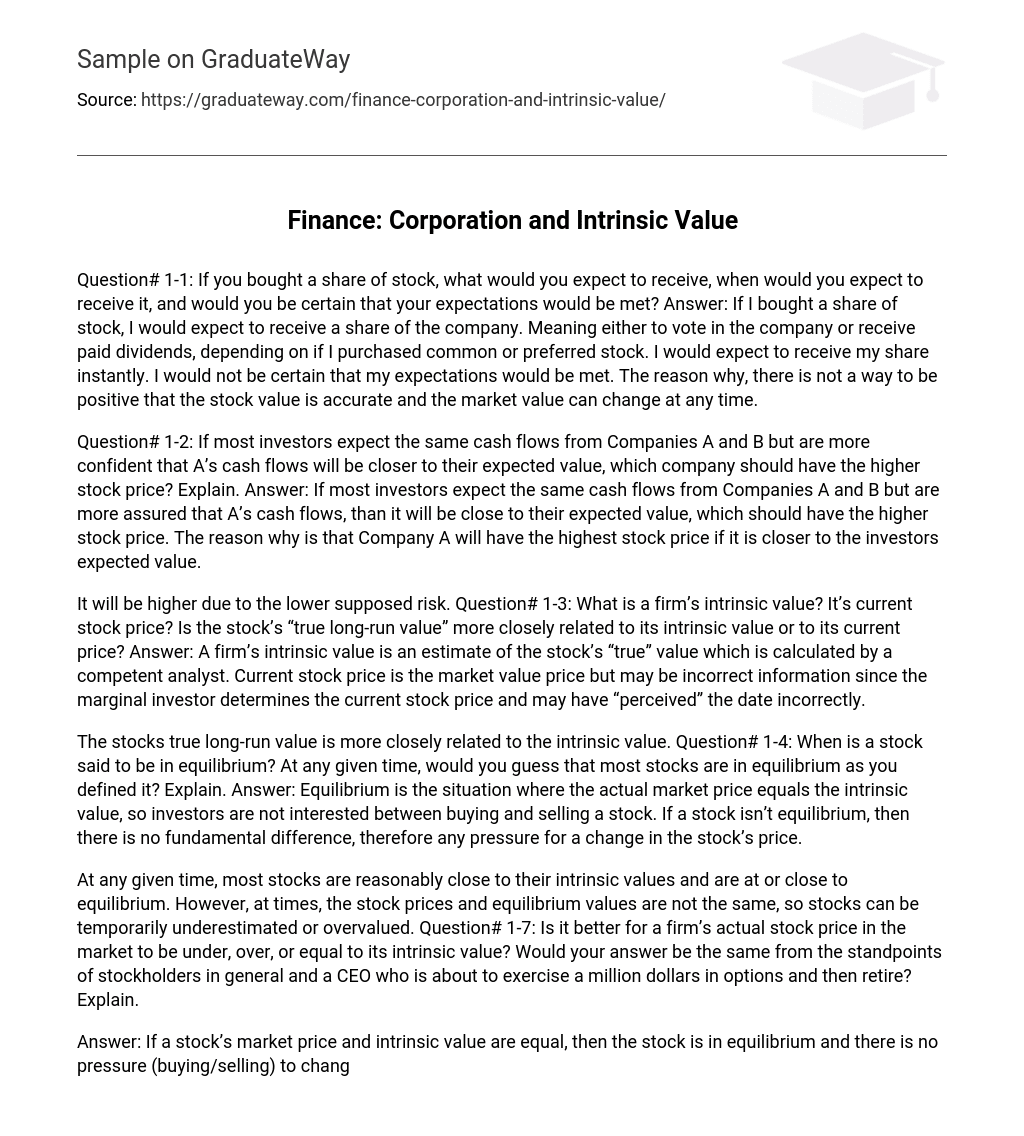Question# 1-1: If you bought a share of stock, what would you expect to receive, when would you expect to receive it, and would you be certain that your expectations would be met? Answer: If I bought a share of stock, I would expect to receive a share of the company. Meaning either to vote in the company or receive paid dividends, depending on if I purchased common or preferred stock. I would expect to receive my share instantly. I would not be certain that my expectations would be met. The reason why, there is not a way to be positive that the stock value is accurate and the market value can change at any time.
Question# 1-2: If most investors expect the same cash flows from Companies A and B but are more confident that A’s cash flows will be closer to their expected value, which company should have the higher stock price? Explain. Answer: If most investors expect the same cash flows from Companies A and B but are more assured that A’s cash flows, than it will be close to their expected value, which should have the higher stock price. The reason why is that Company A will have the highest stock price if it is closer to the investors expected value.
It will be higher due to the lower supposed risk. Question# 1-3: What is a firm’s intrinsic value? It’s current stock price? Is the stock’s “true long-run value” more closely related to its intrinsic value or to its current price? Answer: A firm’s intrinsic value is an estimate of the stock’s “true” value which is calculated by a competent analyst. Current stock price is the market value price but may be incorrect information since the marginal investor determines the current stock price and may have “perceived” the date incorrectly.
The stocks true long-run value is more closely related to the intrinsic value. Question# 1-4: When is a stock said to be in equilibrium? At any given time, would you guess that most stocks are in equilibrium as you defined it? Explain. Answer: Equilibrium is the situation where the actual market price equals the intrinsic value, so investors are not interested between buying and selling a stock. If a stock isn’t equilibrium, then there is no fundamental difference, therefore any pressure for a change in the stock’s price.
At any given time, most stocks are reasonably close to their intrinsic values and are at or close to equilibrium. However, at times, the stock prices and equilibrium values are not the same, so stocks can be temporarily underestimated or overvalued. Question# 1-7: Is it better for a firm’s actual stock price in the market to be under, over, or equal to its intrinsic value? Would your answer be the same from the standpoints of stockholders in general and a CEO who is about to exercise a million dollars in options and then retire? Explain.
Answer: If a stock’s market price and intrinsic value are equal, then the stock is in equilibrium and there is no pressure (buying/selling) to change the stock’s price. Stockholders in general would probably expect the firm’s market price to be under the intrinsic value, realizing that if management is doing its job that current price at any point in time would not necessarily be maximized. However, the CEO would prefer that the market price be high, since it is the current price that he will receive when exercising his stock options.
Question# 1-8: What are the four forms of business organization? What are the advantages and dis-advantages of each? Answer: The four forms of business organization are sole proprietorships, partnerships, corporations, and limited liability corporations and partnerships. The advantages of Sole Proprietorships and Partnerships are the ease and low cost of formation. The advantages of corporations include limited liability, indefinite life, ease of ownership transfer, and access to capital markets. Limited liability companies and partnerships have limited liability like corporations.
The disadvantages of a sole proprietorship are the difficulty in obtaining large sums of capital and unlimited personal liability for business debts. The disadvantages of a partnership are unlimited liability and difficulty of transferring ownership. The disadvantages of a corporation are the double taxation of earnings and filing required state and federal reports. Finally, the disadvantages of limited liability corporations and partnerships are difficulty in raising capital and the complexity of setting them up.
Question# 1-10: What are some actions that stockholders can take to ensure that management’s and stockholders’ interests are aligned? Answer: Some actions that stockholders can take to ensure management are motivational tools that will help in supporting stockholders’ and management’s interests. Some interest include: reasonable compensation packages, direct intervention by shareholders, including firing managers who don’t perform well, and the threat of takeover.





